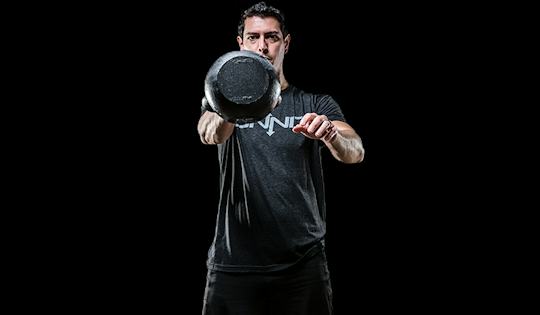The Kettlebell Swing exercise is one of the most iconic and beneficial kettlebell drills. This ballistic movement helps to strengthen your core and hips while encouraging full body utilization and coordination.
Perfecting your timing and technique allows for safe, high repetition sets that will improve work capacity, functional explosiveness, and muscular endurance. It’s also a “gateway” into a variety of other ballistic kettlebell exercises that have even more benefits for your strength, conditioning, and agility.
While it is also highly beneficial (and recommended) that you are taught by a kettlebell professional, there are some key points to this deceptively technical exercise that will help you perform it with proper form. Even if you’ve been taught by someone who knows what they’re doing, it’s still easy to deviate from the path when you’ve been doing it for a while.
Remembering these five key points will keep your form intact while helping you continually progress to heavier kettlebell weights.
Key Point #1: The Swing is a Hinge, Not a Squat
There are several variations of the Kettlebell Swing, but the standard form of the exercise is a hinge at the hips, not a squat. If you aren’t feeling a stretch in your hamstrings as you perform each repetition, you are probably bending at the knees and squatting rather than hinging at the hips and activating your posterior chain. Keep a tight core, straight back, and get your hips behind your centerline.
Key Point #2: The Swing is Explosive, Not Passive
The primary benefit of the Kettlebell Swing is the ability to use a ballistic, explosive movement with your hips to build core strength and conditioning. Again, while there are variations (the Girevoy Sport/Kettlebell Sport “efficient” variation in this case), the standard form requires an explosive hip “snap” to drive the weight forward.
If your hips aren’t moving behind your centerline, chances are that you are literally just swinging the kettlebell like a pendulum between your legs. This could conceivably build some hook grip/forearm conditioning, but there is no way you’re improving your core strength like you should be with the Swing. Move those hips and explode forward!
Key Point #3: Leaning Back at the Top of the Swing is Wrong & Dangerous
I can’t emphasize this enough, the Kettlebell Swing is an explosive core strengthening exercise; with that said, you need to be activating your core during the drill! This is achieved at the top of each repetition as the kettlebell reaches the apex of the swing.
The hip snapping movement described in point #2 ends when the kettlebell reaches 45 degrees out from your body. What stops the hip motion is the flexing of your gluteus maximus and your abdominals. Doing this should force your body into a completely vertical position with good posture, fully engaging your core.
Key Point #4: Let the Kettlebell Drag You Down, Don’t Follow It
The kettlebell should end up between your legs directly below your butt at the beginning and ending with good form. Your arms should be locked out, hips behind your center line, knees slightly bent, and your spine should be neutral.
This position is impossible to achieve if you are falling with the kettlebell rather than letting the kettlebell fall by itself and allowing it to drag you down with it. If you start hinging at the hips the minute the kettlebell starts falling, the kettlebell will end up in between your knees, much lower than proper form dictates. Starting/ending from this point will make proper form impossible.
Key Point #5: The Kettlebell Gets as High as Your Hip Explosiveness, Not Your Objective
Some organizations have some very steadfast rules about how high the kettlebell should end up at the apex of the Swing exercise (primarily they say it should be at a completely parallel position to the ground), we only have guidelines instead. Ideally the kettlebell and your arms end up parallel to the ground, but the height is really determined by how explosive you are with your hip snap.
If that hip snap only gets the kettlebell part way to a parallel position with the ground, so be it. Remember, trying to muscle through the movement by engaging your deltoids and upper body (essentially performing a front raise) is not the point of the exercise, explosive hip/core action is. Don’t sacrifice form to meet some “objective” that proper form dictates.
There you have it! If you must, watch some videos online and practice at home incorporating these key points to good form. They may seem strange at first, but as soon as you start performing reps, you’ll see how applicable they are to maintaining proper form.

)





